Australia & the Pacific: a history
This is an important book that will make waves. In Australia & the Pacific, Ian Hoskins ventures into pointedly political waters, particularly the autonomy of First Nations peoples and the environmental implications of Australia’s extractive industries.
READ REVIEW
↓
Australia & the Pacific: a history
Ian Hoskins | 2021
The last decade has witnessed two major transformations in Australian historiography. The first is a mainstream embrace of environmental history, and with it a deep-time perspective that draws in geological, climatological and biological stories. The second lies in acknowledging that there are manifold Indigenous perspectives on the past, in addition to the multiplicity of colonising archives. Both of these developments require us all as historians to broaden and rethink our sources, narratives and nuances – as well as our audiences’ evolving expectations.
As a seasoned and celebrated author, Ian Hoskins has both embraced and led these changes. His histories of Sydney Harbour and the New South Wales coast are both historically diverse yet embedded in the landforms and seascapes that they lovingly describe. One of Hoskins’ signature techniques is to locate human stories that embody the themes that he wishes to explore with readers. Aware of his own investigative and interpretive focus, Hoskins is not afraid to tackle topics often avoided by others, such as the complex spiritualities and legacies of missionary work, as well as political subjects.
Australia & the Pacific: a history is effectively balanced around the turn of the twentieth century, affording equal weight both to Aboriginal and colonial Australia, and then to the Commonwealth and our globalised continent. The first half, in particular, is lapped continually by the Pacific Ocean, although its blue water potency ebbs somewhat after 1901. Likewise, Hoskins draws the narrative together around two key themes. ‘Through their delivery of people and ideas, the impact of European philosophy and religion upon the Pacific has been fundamental and paradoxical’, he writes. ‘It has unified and devastated, liberated and disempowered.’
In researching the work, Hoskins travelled to several Pacific destinations. Papua New Guinea has a particular impact on his portrayal. ‘Shared ecology is just one element among many in Australia’s complex and vastly under-appreciated relationship with its northern neighbour’, he muses. Other elements are divergent cultural and topographical landscapes, as well as the painful politics of imperialism, League of Nations mandates, and post-colonial independence. Papua New Guinea is a looming presence over much of this book, reminding us that continental boundaries do not constrain historical trajectories.
Australia & the Pacific is richest in its first half, where Polynesian venturers dwarf the achievements of early European chancers and pirates. Dispelling Eurocentric myths, Hoskins outlines the polyglot nature of early colonisation, trade and industry, particularly based around Sydney Harbour. The stories occasionally venture inland, but it is maritime connections and conflicts that animate each pre-Federation chapter. The account also ensures that simplistic racialised depictions are displaced by an acknowledgement of changing European ideas of race and civilisation. ‘Colonists increasingly comprehended the examples of human existence around them as evolution, social if not scientific’, Hoskins remarks. Moreover, he adds, a British desire to limit imperial over-reach counteracts naïve assumptions about naval and political dominance.
Arguably, capital and labour play more overt roles in this history than politics and brute imperial violence. This renewed understanding of financial forces and the humans caught in their flows also reflects a slow renaissance in economic history that is gaining ground amongst Australian historians. ‘Conveniently located’, Hoskins proposes, by 1883 ‘New Guinea was now in the purview of labour recruiters after 10 years of missionary activity and peripheral exploration’. A similarly acquisitive gaze followed Europeans around the Pacific, with selective benefits and blame leading back to New South Wales and Queensland in particular.
As the book moves toward the twentieth century, the Pacific Ocean recedes and Hoskins focuses more on federal politics and changes in the Australian population and polity. I felt that the purpose of the work shifted at this point, with more political critique and a lessened interest in the individual stories that had animated the first half. Hoskins nevertheless draws us back to the seashore, especially outlining the role of bathing and surfing in transforming how east-coast Australians relate to the world’s largest ocean. Indeed, he argues, ‘Australian masculinity received a most significant gift from the Pacific in the 1880s with the introduction of the art of body surfing’.
Despite its 400-plus pages of text, there are naturally many elements that deserve more attention in understanding Australia’s relationship with the Pacific, such as naval ambition and aviation. Nevertheless, the author has used an impressive span of primary and secondary sources to cover as much territory – and ocean – as he has. The text is crafted with his usual inventive, pointed and engaging prose. Once again, Ian Hoskins had demonstrated that he is a masterful writer who brings great credit to all of us professional historians.
Reviewer: Peter Hobbins, Australian National Maritime Museum and PHA (NSW & ACT)
Australia & the Pacific is published by NewSouth Publishing.

